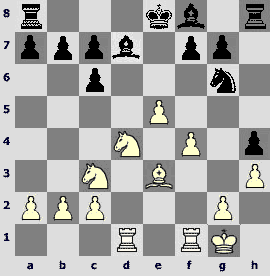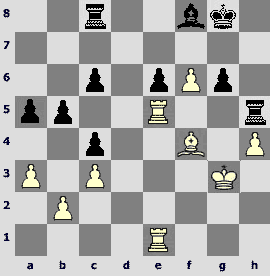19.02.2006
Linares round 1: Svidler - Topalov
Svidler - Topalov [C67]
Annotated by Konstantin Sakaev
1.e4 e5 2.¤f3 ¤c6 3.Ґb5 ¤f6 4.0-0 ¤xe4 5.d4 ¤d6 6.Ґxc6 dxc6 7.dxe5 ¤f5 8.Јxd8+ ўxd8 9.¤c3 ¤e7 This continuation recently became fashionable. Black knight is directed to g6, where it hampers developing of White's kingside initiative.
10.h3 ¤g6 11.Ґg5+ Also ultramodern treatment of the variation. An unhurried development of the queen's bishop to b2 nowadays becomes rare. With this seemingly aimless check White prevents Black's king from running to the queenside, as Black's bishop is stuck on c8.
11...ўe8 12.¦ad1 Ґd7 13.¤d4 Typical middlegame play! Peter does not waste time on queenside prophylaxis, preparing e5-e6 break or the f-pawn advance. Doubling rooks on the d-file is too primitive: 13.¦d2 Ґe6 14.¦fd1 Ґe7 15.Ґe3 (Black risks nothing after seemingly aggressive 15.¤e2?! ¤xe5! 16.¤xe5 Ґxg5 17.f4 Ґe7 18.¤d4 Ґc5 19.ўh2 Ґxd4 20.¦xd4 f6 21.¤d3 b6 22.g4 g6 23.f5 gxf5 24.¤f4 c5 25.¤xe6, and a draw, Svidler,P-Kramnik,V/Dortmund 2004. In my opinion, only White was at risk in this game) 15...a6 16.¤e2 ¦d8 17.¦xd8+ Ґxd8 18.b3 Ґe7 19.c4 h5 20.¤fd4 Ґc8 21.f4 h4, with complex and dynamically balanced position, Polgar,J-Topalov,V/Sofia 2005. 13.a3 looks logical, depriving the bishop of the b4-square, but this loses an important tempo: 13...h6 14.Ґc1 (or 14.Ґe3 Ґe7 15.¦d2 b6 16.¦fd1 ¦d8 17.¤e2 c5 18.¤c3 Ґc6 19.¤d5 ¦d7 20.c4, and a draw was agreed in Leko,P-Kramnik,V/Dortmund "Gr B" 2004) 14...¦d8 15.¦fe1 Ґe7 16.¤e4 Ґe6 17.¦xd8+ ўxd8 18.¤d4 Ґd7 - Black is ok, Topalov,V-Vallejo Pons,F/Benidorm 2003.
13...h6 Another possibility is 13...Ґb4. Black's idea is to exchange his dark-squared bishop on a knight and start playing on the light squares. In most cases this plan is sufficient to hold a draw.
14.Ґe3 Interesting is 14.Ґd2!?, leaving the e-file vacant, but then Black utilizes a loose d4-knight: 14...Ґc5! 15.¤b3 Ґe7, and White must lose time to return his pieces to the center; Black has a good game.
14...h5 A move aiming at complex struggle in Topalov's style, but it meets a brilliant refutation. Safer approach is 14...Ґb4! 15.f4 Ґxc3 16.bxc3 c5 17.¤e2 b6 18.¤g3 h5 19.f5 ¤xe5 20.Ґf4 f6 21.¦fe1 Ґa4 with equality, Shirov,A-Almasi,Z/Monte Carlo 2002.
15.f4 h4 If Veselin anticipated Peter's next move, he would go for a quiet 15...Ґe7. Black's position is inferior, but not too bad. My guess is Peter would have played 16.¤e4, and on 16...h4 sacrifice a pawn: 17.f5!? ¤e5 followed by 18.f6 or 18.Ґf4.

16.f5!! ¤xe5 17.f6!! The e5-knight loses support, and this is pretty much about White's achievements for his destroyed pawn center, but it turns out that Peter is happy with it.
17...¦h5 18.¤e4 It is important to strengthen the wedge on f6. One can imagine how Black wanted to castle long in this position...
18...g6 The nail on f6 is no longer in danger, and White methodically strengthens on the central files.
19.Ґf4 c5 Black had drawing chances after 19...Ґd6 20.g4! hxg3 21.¤xg3 ¦xh3 22.¦de1 ўf8 23.¦xe5, but White's advantage is undisputable.
20.¤f3 ¤xf3+ 21.¦xf3 Ґe6 21...¦f5 22.¦e3 Ґe6 23.Ґxc7 c4 24.¦e2! ¦c8 25.¦ed2 ¦d5 26.¦xd5 Ґxd5 27.¦xd5 ¦xc7 28.ўf2 - Black is worse, but has some drawing chances.
22.¦fd3! 22.¤g5 would allow a counterplay: 22...¦d8 23.¦e1 c4!
22...c4 23.¦3d2 c6 23...Ґc5+ now and on the next move is met by 24.ўh2.
24.¤g5 A rook on h5 can rest now.
24...Ґc5+ 25.ўh2 Ґd5 The best practical chance was 25...c3! 26.bxc3 Ґxa2, but it is very difficult to dare playing it, as after a simple 27.¦d7 White's attack remains dangerous.
26.¦e2+ ўf8 27.¦de1 b5 Here 27...c3!? also deserved attention. White would have replied by 28.b3, remaining the pawn structure intact. Still, the c2-pawn is potentially weak, and in future Black could make use of it.
28.c3! a5 29.a3! Exactly! It is better to move the pawns away from the light squares.
29...¦c8 On 29...b4 30.a4! looks strong. In the near future, when White plays g2-g4, and after the exchange on g3 supports the g5-square by h3-h4, and move the knight from g5 to e4, Black will be unable to exchange his light-squared bishop for this knight, as it will lose the weakened c4-pawn.

30.g4! A typical modern Berlin tool.
30...hxg3+ 31.ўxg3 Ґe6 32.h4 ўg8 33.¦e5 Ґf8 After 33...Ґd6 34.¦5e4 Ґc5 35.a4 Black is worse despite his extra pawn.
34.¤xe6 Peter simplified the position under the most favorable terms.
34...fxe6

35.¦d1!! It is possible that this quiet move was overlooked by Topalov.
35...¦h7 Ґad is 35...ўf7 36.Ґg5, and Black's rook is sealed.
36.¦xe6 ¦b7 37.¦e4 Defending against b5-b4.
37...ўf7 38.Ґg5 ¦e8 39.¦xe8 ўxe8 40.ўg4 White just threatens h4-h5, and the f6-pawn decides the fate of the game.
40...¦h7 41.¦e1+ ўd7

42.a4! Now a blow from another side follows, and Black's queenside pawns suddenly turn weak.
42...bxa4 43.¦e5 It is useful to provoke c6-c5 to restrict the Black's bishop.
43...c5 44.Ґf4 In addition, there is now a path for the king.
44...¦h8 45.Ґg3 The simplest is 45.h5, completely sealing the f8-bishop and the h8-rook, but Peter deserved the right to have fun with his brilliant play.
45...Ґh6 46.¦e7+ ўc6 47.Ґf4 47.f7 ¦f8 48.Ґe5 wins, but Peter decided not to calculate the variations.
47...Ґxf4 48.ўxf4 ¦h5 49.¦e5 The f6-pawn queens...
49...¦xh4+ 50.ўg5 ¦h5+ 51.ўxg6 ¦xe5 52.f7 ¦e6+ 53.ўg5 The king returns home. After 53.ўf5? ¦e1 Black wins.
53...¦e5+ 54.ўg4 ¦e4+ 55.ўg3 ¦e3+ 56.ўf2 a3 57.f8Ј Yes, the pawn finally queens. White could keep playing around by 57.bxa3 ¦xc3 58.a4! not giving Black any chances.
57...axb2 Or 57...a2 58.Јc8+ ўb5 59.Јd7+ ўb6 60.Јa4.
58.Јc8+ ўb5 59.Јb7+ ўa4 60.ўxe3 It was not too late to err: 60.Јxb2 ¦f3+ 61.ўg2 (or 61.ўe2 ¦f2+) 61...¦g3+ 62.ўh2 ¦h3+, and a draw!
60...ўa3 61.Јb5 a4 62.Јxc5+ ўb3 63.Јb4+ ўc2 64.Јxa4+ ўxc3 65.Јa5+ Look at another trap: 65.Јd1 b1Ј 66.Јxb1 - stalemate!
65...ўc2 66.Јf5+ ўc1 67.Јf1+ Veselin got tired of his position, and resigned. An excellent creative achievement of Peter Svidler, keep it up! Zenit is the champion! *
First round summary
Aronian-Radjabov
A very complicated game. Levon won it in his typical style, not without flaws. In my opinion, Black was close to equality at some point, but Teimour failed to solve all his problems at the board: it is difficult to play with the weak king.
Vallejo-Leko
Better opening preparation of Peter told in this game - he uncorked a strong novelty, leaving the knight en prise on e4. Vallejo did not manage to overcome difficulties at the board and lost.
Bacrot-Ivanchuk
Also an interesting encounter. First Etienne had the imitative, but Vasily outplayed him in a complex fight and was close to a win himself. Still, his endgame advantage was not enough to win, so the game was drawn.
Svidler-Topalov
Without a doubt, a brilliant of the starting round! The Petersburger won an excellent game against the world champion, creating a masterpiece - positional pawn sacrifice with tactical nuances. By the way, computer evaluations in this game are useless, an engine fails to understand its subtleties - my congratulations to Peter!
Never before the struggle in the main tournament of the year was so rich and uncompromising. Let us watch the games and enjoy more thrilling encounters! *
